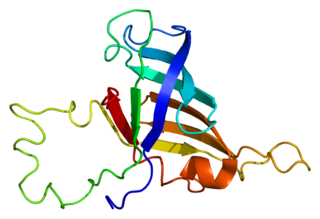Cyclin-T2 is a protein that in humans is encoded by the CCNT2 gene. [5] [6] [7]
Cyclin-T2 is a protein that in humans is encoded by the CCNT2 gene. [5] [6] [7]
The protein encoded by this gene belongs to the highly conserved cyclin family, whose members are characterized by a dramatic periodicity in protein abundance through the cell cycle. Cyclins function as regulators of CDK kinases. Different cyclins exhibit distinct expression and degradation patterns which contribute to the temporal coordination of each mitotic event. This cyclin and its kinase partner CDK9 were found to be subunits of the transcription elongation factor p-TEFb. The p-TEFb complex containing this cyclin was reported to interact with, and act as a negative regulator of human immunodeficiency virus type 1 (HIV-1) Tat protein. Two alternatively spliced transcript variants, which encode distinct isoforms, have been described. [7]
Cyclin T2 has been shown to interact with CDK9 [5] and Retinoblastoma protein. [8]

The positive transcription elongation factor, P-TEFb, is a multiprotein complex that plays an essential role in the regulation of transcription by RNA polymerase II in eukaryotes. Immediately following initiation Pol II becomes trapped in promoter proximal paused positions on the majority of human genes. P-TEFb is a cyclin dependent kinase that can phosphorylate the DRB sensitivity inducing factor (DSIF) and negative elongation factor (NELF), as well as the carboxyl terminal domain of the large subunit of Pol II and this causes the transition into productive elongation leading to the synthesis of mRNAs. P-TEFb is regulated in part by a reversible association with the 7SK snRNP. Treatment of cells with the P-TEFb inhibitors DRB or flavopidirol leads to loss of mRNA production and ultimately cell death.

In molecular biology 7SK is an abundant small nuclear RNA found in metazoans. It plays a role in regulating transcription by controlling the positive transcription elongation factor P-TEFb. 7SK is found in a small nuclear ribonucleoprotein complex (snRNP) with a number of other proteins that regulate the stability and function of the complex.

Cyclin-dependent kinase 9 or CDK9 is a cyclin-dependent kinase associated with P-TEFb.

Cyclin-T1 is a protein that in humans is encoded by the CCNT1 gene.

DNA-directed RNA polymerase II subunit RPB3 is an enzyme that in humans is encoded by the POLR2C gene.

DNA-directed RNA polymerases I, II, and III subunit RPABC3 is a protein that in humans is encoded by the POLR2H gene.

DNA-directed RNA polymerases I, II, and III subunit RPABC5 is a protein that in humans is encoded by the POLR2L gene.

DNA-directed RNA polymerase II subunit RPB11-a is an enzyme that in humans is encoded by the POLR2J gene.

DNA-directed RNA polymerase II subunit RPB4 is an enzyme that in humans is encoded by the POLR2D gene.

CDK-activating kinase assembly factor MAT1 is an enzyme that in humans is encoded by the MNAT1 gene.

Transcription elongation factor SPT5 is a protein that in humans is encoded by the SUPT5H gene.

General transcription factor IIH subunit 4 is a protein that in humans is encoded by the GTF2H4 gene.

HIV Tat-specific factor 1 is a protein that in humans is encoded by the HTATSF1 gene.

Protein HEXIM1 is a protein that in humans is encoded by the HEXIM1 gene.

Transcription elongation factor SPT4 is a protein that in humans is encoded by the SUPT4H1 gene.

Heat shock 70 kDa protein 6 is a protein that in humans is encoded by the HSPA6 gene.

CTD small phosphatase-like protein is an enzyme that in humans is encoded by the CTDSPL gene.

Cyclin-K is a protein that in humans is encoded by the CCNK gene.

Protein HEXIM2 is a protein that in humans is encoded by the HEXIM2 gene.

In molecular biology, Tat is a protein that is encoded for by the tat gene in HIV-1. Tat is a regulatory protein that drastically enhances the efficiency of viral transcription. Tat stands for "Trans-Activator of Transcription". The protein consists of between 86 and 101 amino acids depending on the subtype. Tat vastly increases the level of transcription of the HIV dsDNA. Before Tat is present, a small number of RNA transcripts will be made, which allow the Tat protein to be produced. Tat then binds to cellular factors and mediates their phosphorylation, resulting in increased transcription of all HIV genes, providing a positive feedback cycle. This in turn allows HIV to have an explosive response once a threshold amount of Tat is produced, a useful tool for defeating the body's response.